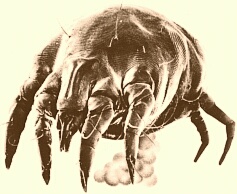House Dust Mite
In late June 2000 I got a new double bed with 1000 rated posturing (I found that 1200 was too hard for my liking, though it is supposed to be higher quality and comes with a higher quality finish). With it I got a Polyolefin (Medishield) air permeable barrier because I am concerned about how my sleeping affects my asthma, especially given the double glazing. Before the bed was delivered I vacuumed the room on hands and knees (making me asthmatic!) and hope to maintain an anti-allergen approach to my sleeping.
The House Dust Mite (or Dermatophagoides Pteronyssinus, meaning skin eating spider)  is a modern curse to asthma, eczema and rhinitus sufferers, whose condition is aggravated by its allergen of a very fine dust which is the decomposing of its faecal pellets (illustrated). An allergen is where there is an interaction between antigen and an antibody, so obviously this varies from individual to individual, but there are common causes and this is one and increasingly so today.
is a modern curse to asthma, eczema and rhinitus sufferers, whose condition is aggravated by its allergen of a very fine dust which is the decomposing of its faecal pellets (illustrated). An allergen is where there is an interaction between antigen and an antibody, so obviously this varies from individual to individual, but there are common causes and this is one and increasingly so today.
The mite is such a problem today because of fitted carpets and draught reduction and/ or double glazing, producing maintained warm conditions. While we sleep we produce sweat and drop skin, which the approximately 2,000,000 mites per double bed happily feed upon. They can be seen by the naked eye, although with difficulty as they move within the soft materials, and on consuming the skin and mould each one excretes 40 pellets ad day and the fine powder makes us wheeze. This builds up, obviously, and can become a significant proportion of the weight of, for example, a pillow.
Information from RHS Ltd., Medibed Anti-Allergy Bedding: The Facts, 1997.
 is a modern curse to asthma, eczema and rhinitus sufferers, whose condition is aggravated by its allergen of a very fine dust which is the decomposing of its faecal pellets (illustrated). An allergen is where there is an interaction between antigen and an antibody, so obviously this varies from individual to individual, but there are common causes and this is one and increasingly so today.
is a modern curse to asthma, eczema and rhinitus sufferers, whose condition is aggravated by its allergen of a very fine dust which is the decomposing of its faecal pellets (illustrated). An allergen is where there is an interaction between antigen and an antibody, so obviously this varies from individual to individual, but there are common causes and this is one and increasingly so today.